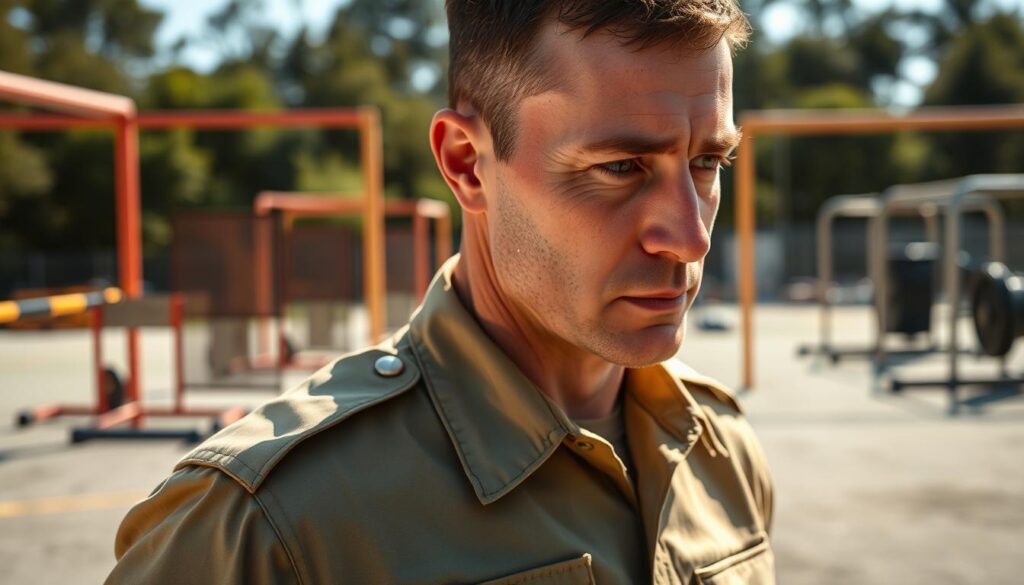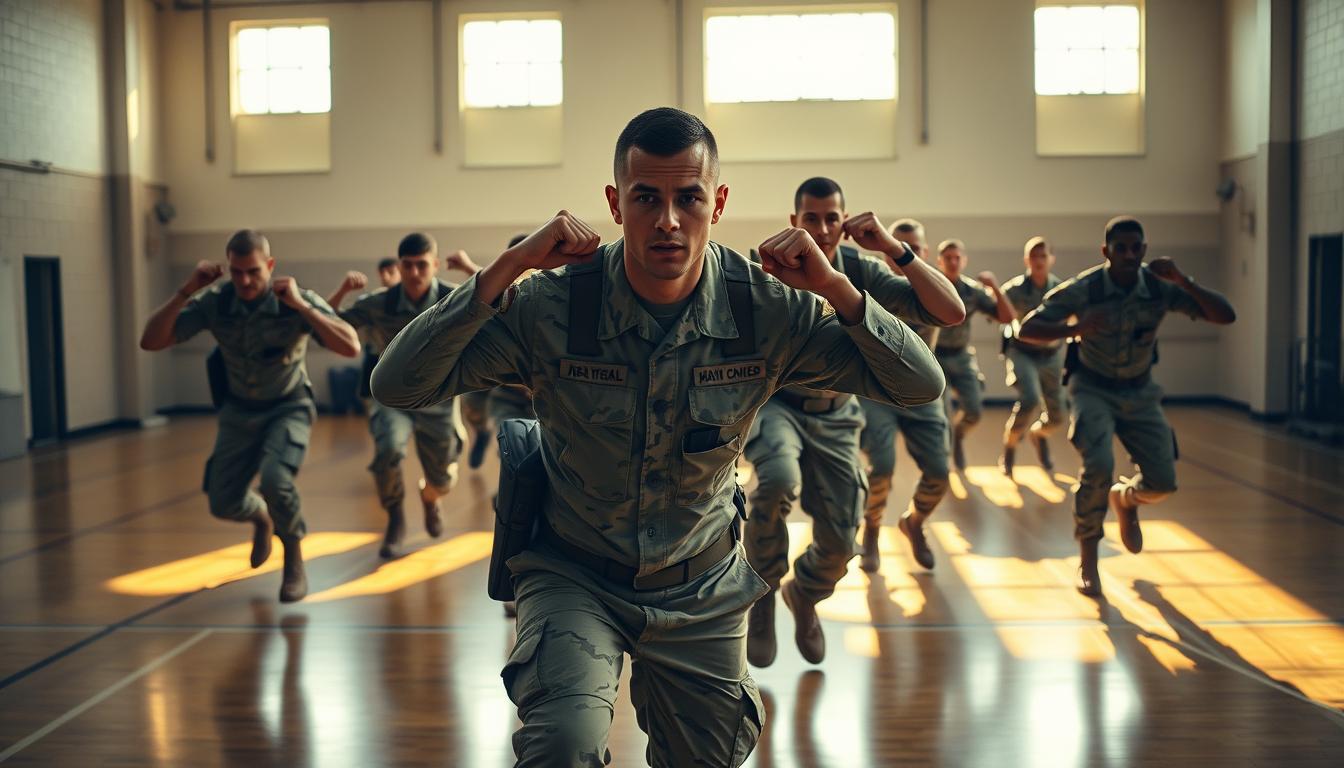Starting June 1, 2025, the U.S. military will have a new way to check if soldiers are ready. The Army Fitness Test will replace the old method. It will use new scoring that focuses on combat effectiveness and readiness.
This change is to make soldiers fitter and more ready for battle. The new test will check if soldiers can handle combat tasks. It’s all about being in top shape.
Key Takeaways
- The Army Fitness Test will be the new standard for military physical evaluation starting June 1, 2025.
- Updated scoring standards will focus on combat effectiveness and readiness.
- The change aims to enhance Soldier readiness and fitness culture.
- The new test replaces the Army Combat Fitness Test.
- Personnel are expected to meet the new fitness requirements for army officers.
Overview of the Army Officer Fitness Test
The Army Officer Fitness Test, or AFT, is key in checking the physical skills of army staff. It aims to boost the fitness of soldiers. This ensures they can handle the physical tasks of military life.

Purpose of the Fitness Test
The AFT checks the strength, endurance, and agility of army officers. It makes sure officers can do their jobs well and safely. It also helps find areas where officers might need more training.
For more details on fitness needs, check the Army Fitness Requirements page.
Key Components of the Test
The AFT has five parts, each testing a different fitness area:
- 3 Repetition Maximum Deadlift (MDL): Tests muscular strength.
- Hand-Release Push-Up (HRP): Checks upper body strength and endurance.
- Sprint-Drag-Carry (SDC): Assesses agility, speed, and coordination.
- Plank (PLK): Measures core strength and endurance.
- Two-Mile Run (2MR): Tests cardiovascular endurance.
These parts aim to challenge officers to their limits. They mimic the physical demands of military life. Knowing the AFT’s components helps officers prepare and boost their fitness.
Physical Requirements for Army Officers
The Army sets high physical standards for its officers. This ensures they can handle the demands of service. The Army Fitness Test (AFT) checks their strength, endurance, and power.

Strength Standards
The AFT tests strength with events like the Maximum Dead Lift (MDL). It checks lower body, grip, and core strength. Officers must meet certain strength levels to pass.
Key strength standards include:
- Lifting a maximum weight in the MDL event
- Demonstrating grip strength
- Showing core muscular endurance
Endurance Standards
The AFT also tests upper body endurance with the Hand Release Push-up (HRP). Officers must do a set number of push-ups in time. It also checks anaerobic power, requiring quick energy bursts.
Endurance standards include:
- Completing a specified number of push-ups in the HRP event
- Demonstrating anaerobic power through other AFT events
Meeting these physical standards is key for Army officers. It helps them do their job well and pass the AFT. Knowing the strength and endurance requirements helps officers prepare for their duties.
Preparing for the Fitness Test
To get ready for the Army Officer Fitness Test, you need a solid plan. This plan should cover training and nutrition. It’s important to work on your physical shape and what you eat.
Recommended Training Regimens
Having a good training plan is key to doing well in the Army Officer Fitness Test. The Army offers fitness centers and recreational sports leagues to help. Your training should mix cardio, strength, and flexibility exercises.
- Cardio exercises like running, swimming, or cycling boost endurance.
- Strength training helps with muscle power and endurance.
- Flexibility exercises improve range of motion and lower injury risk.
For more tips on Army training, check out preparing for basic training.
Nutrition Tips for Optimal Performance
Good nutrition is vital for doing well on the Army Officer Fitness Test. A balanced diet with proteins, carbs, and fats is key for energy and recovery.
Key nutritional tips:
- Eat a balanced diet with lots of fruits, veggies, lean proteins, and whole grains.
- Drink plenty of water all day to stay hydrated.
- Limit sugar and saturated fats.
With a good training plan and the right nutrition, you can do your best on the Army Officer Fitness Test. This will help you reach your goals.
Scoring and Evaluation Methods
To do well in the Army Officer Fitness Test, officers need to know how they’re scored. The test checks many parts of an officer’s fitness. The scoring system shows this in a detailed way.
The test has five parts, each scored differently. Officers must get at least 60 points in each part. The total score is 300 points. Knowing how to score well is key for effective training.
Passing Scores and Benchmarks
To pass, officers must score at least 60 in each event. This adds up to a total of 300 points. The test’s scoring makes sure officers meet the needed physical standards. Here are the scoring benchmarks for the test.
| Event | Minimum Passing Score | Maximum Score |
|---|---|---|
| Event 1 | 60 | 100 |
| Event 2 | 60 | 100 |
| Event 3 | 60 | 100 |
| Event 4 | 60 | 100 |
| Event 5 | 60 | 100 |
| Total | 300 | 500 |
Fitness experts say knowing the scoring system is crucial. For more on military physical standards, check out this resource.
Common Areas of Improvement
Officers often find some events hard. Knowing these areas helps with better training. Events that test endurance and strength are common challenges.
“The key to success in the Army Officer Fitness Test is not just about passing; it’s about achieving a high score. Officers should focus on their weaknesses while maintaining their strengths.” – Fitness Expert
Understanding the army officer fitness assessment and military physical evaluation helps officers prepare. A balanced training plan is essential to cover all test aspects.
Test Variations by Branch
Military fitness tests differ across branches, each with unique challenges. It’s key to know these differences, especially for those moving between branches or focusing on specific areas.
Differences Between Army and Other Military Branches
The Army Fitness Test (AFT) checks Army personnel’s physical readiness. But, other branches have their own tests. For example, the Marine Corps uses the Physical Fitness Test (PFT), which includes pull-ups, crunches, and a three-mile run. The Navy’s Physical Readiness Test (PRT) focuses on push-ups, sit-ups, and a 1.5-mile run or cardio.
Comparative Analysis: The AFT combines strength, endurance, and agility. Yet, other branches might stress different skills. For instance, the Marine Corps PFT highlights upper body strength with pull-ups.
Unique Tests for Specialization Fields
Within the Army, some fields need extra or different tests. For example, Special Forces candidates face tough tests like rucking, swimming, and obstacle courses.
Here’s a comparison of fitness tests across different military branches:
| Branch | Fitness Test | Components |
|---|---|---|
| Army | Army Fitness Test (AFT) | 3 events: strength, endurance, agility |
| Marine Corps | Physical Fitness Test (PFT) | Pull-ups, crunches, 3-mile run |
| Navy | Physical Readiness Test (PRT) | Push-ups, sit-ups, 1.5-mile run or cardio |
| Air Force | Physical Fitness Assessment | Push-ups, sit-ups, 1.5-mile run |
Tips for Success on the Fitness Test
The Army Officer Fitness Test is tough. It tests your physical fitness, mental toughness, and how well you prepare. To do well, you need to train your body and mind.
Mental Preparation Techniques
Mental prep is just as important as physical training. Using visualization and positive self-talk can really help. Visualization lets you imagine yourself doing great and overcoming obstacles. Positive self-talk boosts your confidence and lowers stress.
Effective Mental Preparation Strategies:
- Visualization: Mentally rehearse the test to build confidence and familiarity.
- Positive Self-Talk: Use affirmations to boost morale and reduce anxiety.
- Mindfulness: Practice mindfulness techniques to stay focused and calm under pressure.
“The mind is everything. What you think you become.” – Buddha
Common Mistakes to Avoid
Staying away from common mistakes is key to a high score. Not preparing enough is a big error. Another mistake is ignoring mental prep and only focusing on physical training.
| Common Mistakes | Consequences | Corrective Actions |
|---|---|---|
| Inadequate Physical Training | Poor Performance | Develop a structured training regimen |
| Neglecting Mental Preparation | Increased Stress and Anxiety | Practice visualization and positive self-talk |
| Poor Nutrition | Reduced Energy and Endurance | Follow a balanced diet |
Understanding the value of both physical and mental prep is crucial. A well-rounded approach to training will greatly improve your chances of success.
Resources for Further Preparation
The Army offers many resources to help Soldiers get ready for the Army Fitness Test (AFT). For details on the AFT, including when it starts and how it’s scored, check out the official Army website. This site has a toolkit to help commanders and Soldiers with the AFT.
Official Resources
The Army has official websites and fitness programs to support Soldiers. These resources focus on the AFT’s main parts, like the 3 Repetition Maximum Deadlift and Hand Release Push-up. They also cover Sprint-Drag-Carry and Plank.
Fitness Apps and Programs
There are also fitness apps and programs to help prepare for the army officer fitness assessment. These tools offer training plans and nutrition advice. They’re designed to meet the fitness needs of army officers.


